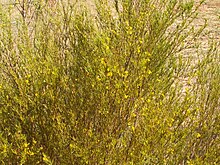
Back Rooibos AF رويبوس Arabic رويبوس ARZ Aspalathus linearis AST Aspalathus linearis BE Ройбос Bulgarian Te ruz BR Roibos Catalan Aspalathus linearis CEB Rooibos Czech
| Rooibos | |
|---|---|

| |
| Prepared rooibos | |
| Scientific classification | |
| Kingdom: | Plantae |
| Clade: | Tracheophytes |
| Clade: | Angiosperms |
| Clade: | Eudicots |
| Clade: | Rosids |
| Order: | Fabales |
| Family: | Fabaceae |
| Subfamily: | Faboideae |
| Genus: | Aspalathus |
| Species: | A. linearis
|
| Binomial name | |
| Aspalathus linearis | |


Rooibos (/ˈrɔɪbɒs/ ROY-boss; Afrikaans: [ˈroːibɔs] ⓘ, lit. 'red bush'), or Aspalathus linearis, is a broom-like member of the plant family Fabaceae that grows in South Africa's Fynbos biome.
The leaves are used to make a caffeine free herbal tea that is called rooibos (especially in Southern Africa), bush tea, red tea, or redbush tea (predominantly in Great Britain).
The tea has been popular in Southern Africa for generations, and since the 2000s has gained popularity internationally. The tea has an earthy flavour that is similar to yerba mate or tobacco.[3][4][5]
Rooibos was formerly classified as Psoralea but is now thought to be part of Aspalathus following Dahlgren (1980). The specific name of linearis was given by Burman (1759) for the plant's linear growing structure and needle-like leaves.
The name rooibos is Afrikaans from rooi bos, meaning 'red bush'. The name is protected in South Africa and has protected designation of origin status in the EU.
- ^ a
- ^ "Aspalathus linearis (Burm.f.) R.Dahlgren". International Legume Database & Information Service. Retrieved 6 May 2016 – via The Plant List. Note that this website has been superseded by World Flora Online
- ^ "(Making the Origin Count: Two Coffees)...And a Tea". www.wipo.int. Retrieved 15 December 2021.
- ^ Curnow, Robyn (2 May 2012). "South Africa's rooibos a hit with tea lovers across the world | CNN Business". CNN. Retrieved 15 December 2021.
- ^ "Aspalathus linearis (Burm.f.) R.Dahlgren". www.gbif.org. Retrieved 15 December 2021.
